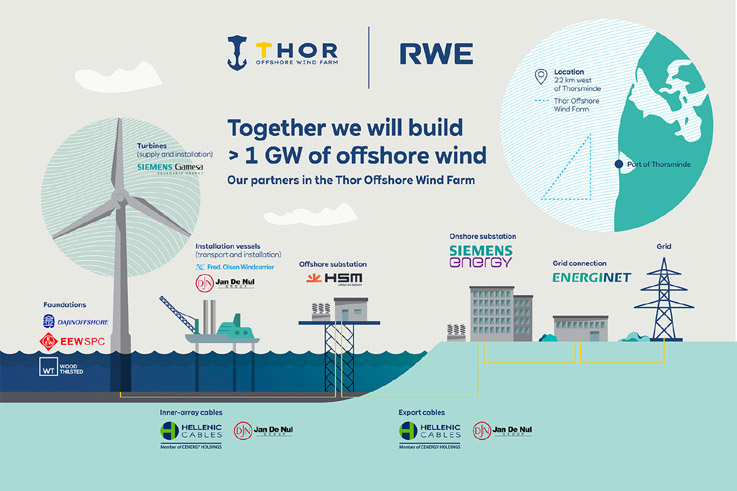RWE will build Thor offshore wind farm in the Danish North Sea, on the west coast of Jutland, approximately 22 kilometres from Thorsminde in the municipality of Holstebro. With a planned capacity of more than 1,000 MW, Thor is Denmark’s largest offshore wind farm to date.
Once fully operational, which is planned no later than the end of 2027, the wind farm will be capable of producing enough green electricity to supply the equivalent of more than a million households, or one in three Danish households.
Timeline
- End 2021: RWE secures concession for Thor offshore wind farm.
- Start 2022: Agreements signed: concession agreement to build Thor offshore wind farm and grid connection with Energinet is signed. Port of Thorsminde is selected as Operations & Maintenance base.
- End 2022: Announcement of preferred suppliers.
- Start 2023: All main components are secured. Announcement that RWE will be first developer globally to install GreenerTowers at Thor to drive wind power sustainability. Groundbreaking for the onshore substation.
- Mid 2023: Announcement that the worldwide-first recyclable blades will be installed at Thor to drive sustainability.
- End 2023: First 'steel cutting' for offshore substation.
- Start 2024: The production of turbine foundations for Thor was kicked off with a First Steel Cutting Ceremony.

Components and innovation
The Thor offshore wind farm will comprise a number of key components that will all work together to generate, transmit and convert green energy to be fed into the National Grid. It requires state-of-the-art technology and innovative engineering and each component has to work seamlessly with the others, each playing a pivotal role in the success of the project.
Wind turbines and foundations
Siemens Gamesa will deliver 72 offshore wind turbines (SG 14-236 DD). 36 monopile foundations will be manufactured by EEW SPC and further 36 monopile foundations and secondary structures will be delivered by Dajin Offshore. The foundations, which are up to 100 metres in height, will each weigh approximately 1,500 tonnes. The Danish-British engineering company, Wood Thilsted, designs the foundations. Jan De Nul Group will provide the vessel for the foundation installation works, which are expected to be carried out in 2025.
Fred.Olsen Windcarrier will provide the vessel for the turbine installation. The installation work is scheduled to start in 2026. Both RWE and Siemens Gamesa intend to draw on the skilled local workforce during both construction and commissioning of the project, both in the harbour as well as offshore.
Transmission system
A consortium between Hellenic Cables and Jan De Nul Group will provide the entire cable package. The two companies will manufacture and install 60 kilometres of export cables on the 30-kilometre-long cable route from the offshore wind farm to shore and approximately 200 kilometres of inter-array cables, connecting the turbines to the offshore substation. Offshore installation and commissioning of the cable system is expected in 2025.
In addition, the consortium will manufacture and install the onshore cables from the landfall to the onshore substation, which will be built by Siemens Energy in the municipality of Lemvig. Siemens Energy will carry out the civil engineering and construction work together with MT Højgaard Danmark, one of Denmark’s leading companies for large-scale building and infrastructure projects.
HSM Offshore Energy has been selected for the engineering, procurement, construction, installation and commissioning of the offshore high voltage substation and its jacket foundation. Installation of the jacket foundation and substation topside is expected to take place in 2025 – followed by the commissioning and testing of the offshore substation in 2026.
Installation vessels
“Les Alizés” is a purpose-built vessel designed for transporting, lifting and installing wind turbine foundations. It will be the largest heavy lift vessel in Jan de Nul's fleet. With the ability to lift up to 5,000 tonnes and with a deck loading capacity of 61,000 tonnes, it is future-proofed by being capable of handling the scale and design of future foundations that will support the next generation of wind turbines.
For the turbine installation, Fred. Olsen Wind Carrier will make use of one of the two Tern class installation vessels, which by the time of the project execution, will feature a new and upgraded crane with a lifting capacity of 1,600 metric tons at 31 metres as well as other upgrades to the vessels including jacking system. The new crane is fully electric and has a lower environmental footprint.
KeyFacts Energy: RWE Renewables Denmark country profile l KeyFacts Energy: Projects Database
 KEYFACT Energy
KEYFACT Energy